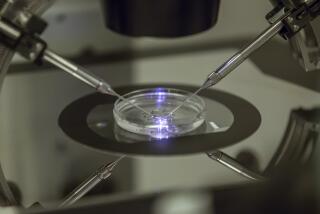New Approach to In-Vitro Fertilization Saves Money
- Share via
A new procedure for in-vitro fertilization is less costly than traditional procedures and yields comparable pregnancy rates, advocates of the approach say. The technique is called Natural Cycle Ovulation Retrieval in In Vitro Fertilization, NORIF for short. There is no hormonal stimulation of ovulation, as in traditional IVF. Instead, ovulation is allowed to occur naturally. Then the patient goes to the doctor’s office a few hours before egg release is likely so the doctor can retrieve and later fertilize the egg.
Here, two experts discuss the pros and cons of NORIF.
Dr. William G. Karow, medical director of the Southern California Fertility Institute; author, “A Baby of Your Own: New Ways to Overcome Infertility”
“NORIF is definitely less costly, but the return is less. In a traditional IVF cycle, 85 of 100 women do not conceive or conceive and miscarry. The take-home baby rate for IVF is 15%. The take-home baby rate for NORIF is about a third (of that). With NORIF, you retrieve zero to two eggs. With traditional IVF, it’s two to 40 eggs.
“And a woman going through NORIF experiences the same anticipation, stress and disappointment as a woman going through IVF.”
Dr. Michael Kamrava, Los Angeles infertility specialist and reproductive endocrinologist; UCLA clinical instructor of reproductive endocrinology and infertility
“NORIF does not require general anesthesia or hospitalization and costs a quarter of what traditional IVF costs. NORIF does not require administration of potent fertility hormones, thereby reducing risks and side effects, including multiple pregnancies and hyper-stimulation of the ovaries.
“The success rate so far seems to be close to the rate for traditional IVF. With NORIF, we are running a 15% to 17% pregnancy rate.”






